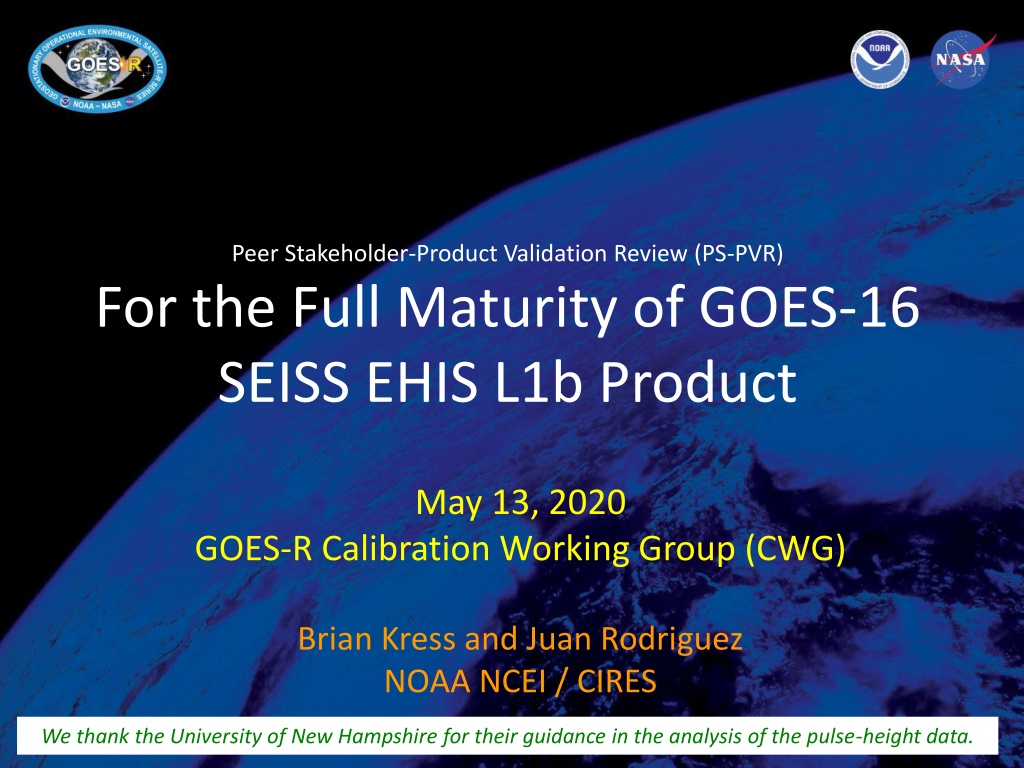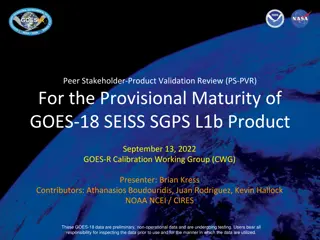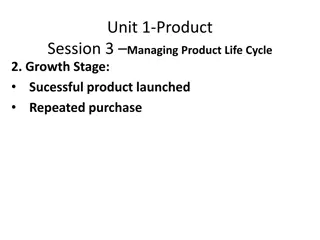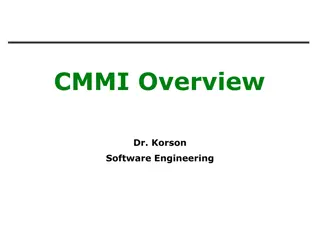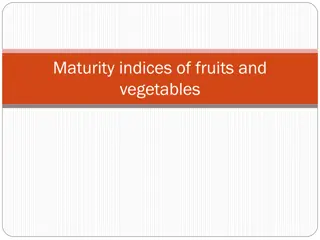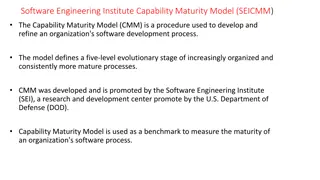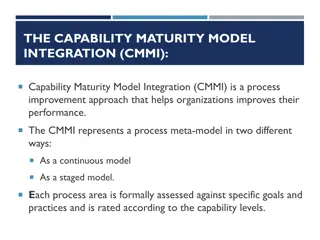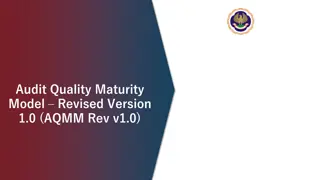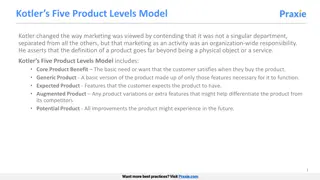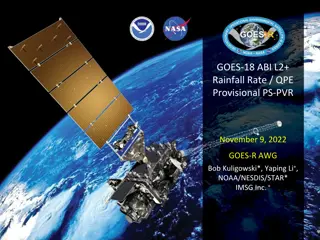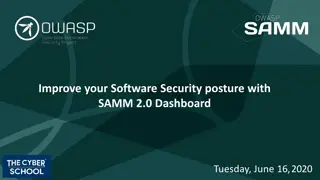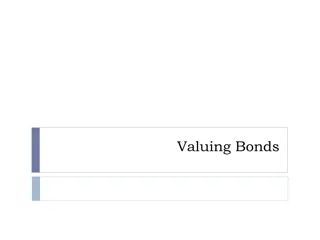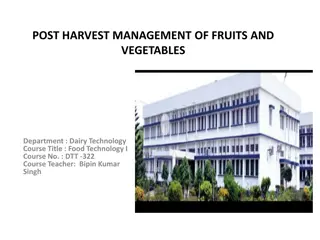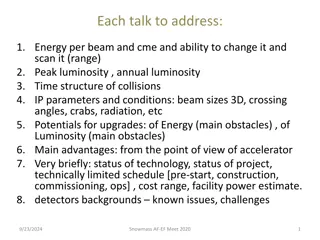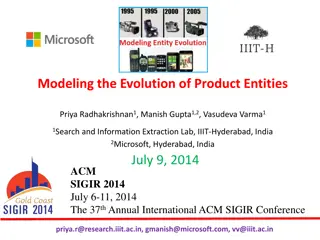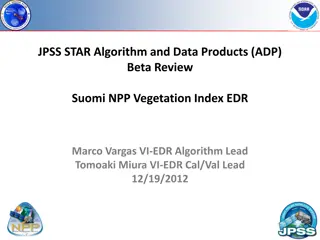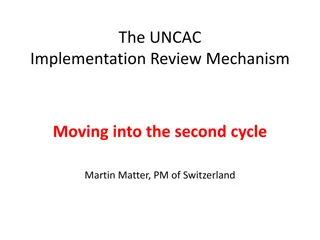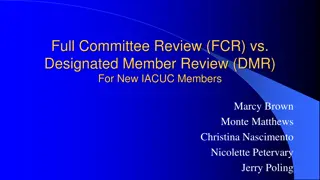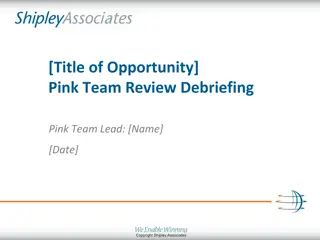Review of GOES-16 SEISS EHIS L1b Product Maturity
This review focuses on the Peer Stakeholder-Product Validation for the full maturity assessment of the GOES-16 SEISS EHIS L1b Product. It includes an overview of the EHIS, anomalies, resolution status, and recommendations. The Energetic Heavy Ion Sensor aims to measure solar energetic particles and galactic cosmic rays to address Single Event Effects in electronics. The review also discusses the Energetic Ions in Space, EHIS L1b Level-2 LET Product, and its objectives in expressing heavy ion fluxes.
Download Presentation

Please find below an Image/Link to download the presentation.
The content on the website is provided AS IS for your information and personal use only. It may not be sold, licensed, or shared on other websites without obtaining consent from the author. Download presentation by click this link. If you encounter any issues during the download, it is possible that the publisher has removed the file from their server.
E N D
Presentation Transcript
Peer Stakeholder-Product Validation Review (PS-PVR) For the Full Maturity of GOES-16 SEISS EHIS L1b Product May 13, 2020 GOES-R Calibration Working Group (CWG) Brian Kress and Juan Rodriguez NOAA NCEI / CIRES We thank the University of New Hampshire for their guidance in the analysis of the pulse-height data.
Outline EHIS Overview / Introductory Material Review of Provisional Maturity Assessment Product Quality Evaluation - Summary of EHIS Anomalies and Resolution Status - PLPTs Supporting Assessment for Full Status Full Maturity Assessment Summary and Recommendations 2
Energetic Heavy Ion Sensor (EHIS) MRD 3.3.6.1.1 Energetic Heavy Ions Primary purpose: measure fluxes of solar energetic particles (SEPs) and galactic cosmic rays (GCRs) responsible for Single Event Effects (SEE) in electronics Single solid-state telescope using angle-detecting inclined sensor (ADIS) system to discriminate heavy ions by atomic number (Z) L1b cadence is 5 minutes FM1 (SN101) CDRL79 release: SEISS-D-EH079-1, Rev D (3 May 2016) Contains constants used in L1b LUT and in flight tables Current EHIS FM1 LUT: "SeissEhisCalInrParameters(FM1 A_CDRL79RevD_DO_07_00_00)- 582860861.0.h5" inclined detectors scintillator Credit: SEISS-D-SY079_EHIS_CALTIM_Update-1-6-14 3
Introductory Material From Solar Terrestrial Physics, Akasofu and Chapman, 1972. Energetic Ions In Space GCRs (Galatic Cosmic Rays) Always present in space Energies up to and > 1011GeV Flux 0.6 particles / cm2 / sec 99.5% Hydrogen & Helium ions (protons and alphas) SEPs (Solar Energetic Particles) Produced during Solar Particle Events (SPEs) lasting one to several days. Mostly < 500 MeV protons Flux up to 105particles / cm2 / sec Most are shielded by the earths magnetic field at latitudes < 60o. 4
EHIS L1b Level-2 Linear Energy Transfer (LET) Product SEE hazard increases with increasing LET Objectives of L2 LET Algorithm: Implement original motivation for EHIS: to express heavy ion fluxes in units of LET in silicon for the spacecraft design and testing communities (single-event effects (SEEs)) Provide a 1-D real-time estimate of LET in silicon for situational awareness, under shielding characteristic of robotic spacecraft (50, 100, 500 mil Al) Be readily adaptable for use in retrospective (e.g., hourly, daily, event, solar rotation) LET estimates Transform EHIS spectra from ions / [cm2 s sr (MeV/n)] to ions / [cm2 s sr (MeV cm2 / mg)] 5
GOES-17 EHIS L1b Product Provisional PS-PVR REVIEW OF PROVISIONAL MATURITY 6
Path to Full (Excerpts from Provisional PS-PVR) EHIS ADR/WR Status Low He Measurement Issue Changes to GOES-16 EHIS flight science tables (ATC/UNH) PLPT overview 7
All EHIS ADRs/WRs to-date closed, except 727, 1025, and 1064, associated w/ too-low He measurement ADR# WR# Short Description Status G16 G17 Expected Closure 267 5370 LUT Filenames not Traceable to Metadata Closed DO.07.00.00 Inaccurate SWx Instrument_ID Fields (FM2, should be FM1) 342 Closed DO.06.03 414 4920 Start and End Time Stamps for SEIS-L1b-EHIS Closed DO.07.00.00 Ground LUT in OE to bring L1b in line with FSW table changes 428 Closed 26 Jan 2018 510 5413, 5483 SWx L1b generation slowdown / stoppage Closed DO.07.00.00 Small but routine L1b gaps, mostly for SEISS (EHIS, MPS-LO, MPS-HI) resolved by WR4431 in DO.06.03 517 4431, 3802 Closed EHIS Flags read incorrectly: HFR_Flag, IFC_Flag, SCC_Flag 582 5762 Closed DO.06.03 703 6146 Replace Be and B fluxes with fill values Closed PR.07.02.00 GOES-16 EHIS unexpected low fluxes from lowest energy helium channel (HE1) 727 6113 Open Flight WR SEISS EHIS L1b StatErrorsBounds variables issue [incorrect dimension name: energy_bounds instead of error_bounds ] confirmed in DE for G16 PR.07.02.00 DO.08.00.00 804 6661 1025 Add Helium to the SGPS Product In_Analysis unknown Post- Provisional PS-PVR ADRs 1064 SEISS EHIS He conversion from SGPS In_Analysis unknown 8
Reported He Ion Flux is Low Reported G16/FM1 EHIS HE1 Ion Flux up to an order-of-magnitude low in comparison with SGPS, G13-15, and ACE measurements. The root cause is not understood and thought to be an instrument problem, likely to also be an issue with GOES-17, -T, and -U. Associated ADRs are 727, 1025, and 1064. 9
ADR 727: Evaluation of Alternatives The lowest-energy GOES-16 EHIS helium channel (HE1) registered fluxes a factor of 6-7 low during the 10 Sept 2017 SEP event - There is evidence for this internal to the instrument (UNH) and by cross-comparison with other helium measurements (NCEI) This violates 25% accuracy requirements in PORD (SEISSPORD160) and MRD (1983) Despite extensive investigations by UNH, the root cause has not been identified In September 2018, UNH recommended attractive algorithmic fixes that use helium PHA samples This approach relies on the PHA packets during every 5-minute interval containing a significant number of helium samples (295 PHA packets per 5 minute interval) Heavy ion counts take first priority in the PHA packets - Analysis presented in G17 EHIS Provisional PS-PVR showed that there will not be sufficient helium samples in the PHA packets in a 5-minute period. 10
Changes to FM1 EHIS Tables Resulting from PLT Date Rationale Changed L0 L1b Logic changes: remove ~1.5-6.0 MeV electron contamination in H1; remove noisy D2A trigger level from logic (affects H & He). 10 Mar 2017 Flight science tables x x 20 Jun 2017 Incorporate on-orbit PLT calibration results (ZCAL, prime trigger condition) Flight science tables x x 26 Jan 2018 Bring L1b in line with FSW table changes Ground LUT in OE (ADR 428) x Notes for FM2: 1. FM2 launched with same logic as FM1 configured on 10 Mar 2017 -- removed electron contamination from the start. However, FM2 does not have a noisy D2A. Removal of D2A from logic complicates the H and He energy passbands. Consider reconfiguring FM2 logic to only address electron contamination. 2. Make sure to coordinate GPA LUT change to be simultaneous with incorporation of PLT results into flight tables. 11
Provisional PLPTs Title A.2.4 SEP Channel Cross-Comparison [PLPT-SEI-004] Activity On-orbit cross-calibration of EHIS with SGPS above 10 MeV, and with GOES 13-15 EPEAD. Data Needed One Solar Energetic Particle (SEP) event. Success Criteria [Provisional] Differences quantified on data taken through Provisional phase. [Provisional] Natural backgrounds preliminarily correlated with solar protons and GCRs. A.2.6 Backgrounds Trending [PLPT- SEI-006] Evaluate EHIS backgrounds in terms of expected galactic cosmic ray (GCR) fluxes. The analysis of EHIS heavy ion data will require long-term averages of L0 histograms. The Analysis of EHIS proton and alpha particle rates and SGPS rates from the other two instruments could be used to convert L1b fluxes back to counts, but it would be less ambiguous to simply average the EHIS L0 count rates. Two months of continuous data. EHIS PLPTs from RIMP v 1.0 (02 June 2016) Note: Data requirements for Full Validation have been exceeded in Provisional analysis. - A.3.3: 2 SEP events required vs. 3 SEP events analyzed (14-16 July and 5-8, 10-14 Sept. 2017) - A.3.5: 4 months of data required vs. 5.5 months analyzed Provisional success criteria require quantification of calibration differences without necessarily resolving them. Success requires sufficient analysis to reveal the important issues that need to be pursued in Full Validation phase. 12
GOES-17 EHIS L1b Product Provisional PS-PVR PRODUCT QUALITY ASSESSMENT 13
Product Quality Assessment Summary of EHIS Anomalies and Resolution Status PLPTs for Provisional Performance Baseline Status 14
Overview of Some Important Anomalies, Fixes and Analysis Anomalies and Fixes - Electron contamination in H1 Fixed with upward adjustment of H1 lower energy bound; Flight science table update, 10 Mar 2017. - HFR_Flag, IFC_Flag, and SCC_Flag not read correctly (ground processing issue) Fixed with ADR 582. - Low He flux measurement Will be addressed with ADRs 1025 and 1064; SEISS vendor is making rapid progress on SGPS Helium modeling and GPA update (SEA38). PLPT Analysis - PLPT-SEI-004: EHIS September 2017 SEP event H, He and heavy ion fluences compared with GOES-13, -15, SGPS and ACE. - PLPT-SEI-004: EHIS H and He measurement cross correlations with GOES-13 and -15. - Developed NCEI in-house pulse height analysis (not part of operational use/processing) to evaluate heavy ion Backgrounds for PLPT-SEI-006, and to test heavy ion measurement by FM2 (with no SEP event). 15
ADRs 1025 and 1064 ADRs 1025 and 1064 submitted to address EHIS He measurement problem (seen on slide 9). Path forward is to process He counts currently reported in SGPS L0 data and include in SGPS and EHIS L1b: Flight/Vendor Add demonstrated algorithm to CDRL 80 Calibrate SGPS alpha channels (geometric factors, proton contamination) Ground Implement Flight algorithm to add helium variables to existing SGPS product Additional data volume in GRB NCEI Develop algorithm & software to calculate Level 2 5-minute averages of SGPS helium fluxes (adaptation/extension of existing averaging software) Modify existing Level 2 LET algorithm & code to ingest SGPS helium fluxes and create LET spectrum from SGPS data Deliver as part of Phase 3 to NWS/SWPC (work planned 2020-06-30 through 2020-12-31) NWS/SWPC Transition NCEI-developed code to operations 16
PLPTs for Provisional PLPT-SEI-004 SEP Channel Cross-Comparison PLPT-SEI-006 Backgrounds Trending 17
PLPT-SEI-004 SEP Channel Cross Comparison Hydrogen Ions G13, G15, SGPS, and EHIS hydrogen ion event fluences from Sept. 2017 SEP ground level event. 18
PLPT-SEI-004 SEP Channel Cross Comparison Hydrogen Ions Energy (MeV) Example of G13, G15, SGPS, and EHIS hydrogen ion energy spectra, at 7:30 UT, during 11 Sept. 2017 SEP ground level event. EHIS H1 and H2 channels are here lower than G13, G15, and SGPS measurements by a factor of 5. Operational Hydrogen fluxes are obtained from SGPS. 19
PLPT-SEI-004 SEP Channel Cross Comparison Hydrogen Ions x10 Fit to flux Fit to log flux Scaling needed to obtain G-13, -15 from EHIS Significant difference in scale factor, between fit to log(flux) and fit in linear space, indicates nonlinear relation. For log flux fit, scale factor taken as =10(intercept), i.e., slope (exponent) 1. G13, 15 hydrogen ion flux is a factor of 3-5 higher than EHIS H1-H4. EHIS H5 is 2-3 times higher than G13, 15. Chan. (MeV/n) G13 G15 Fit to: flux Log flux flux Log flux H1P (16.8) 3.8 3.2 5.2 4.6 H2P (36.0) 3.2 2.7 3.5 3.0 H3P (60.9) 3.5 4.6 3.8 5.0 H4P (132.) 3.1 4.5 3.0 4.8 H5P (206.) 0.27 0.44 0.30 0.59 20
PLPT-SEI-004 SEP Channel Cross Comparison Helium Ions G13, G15, SGPS, and EHIS helium ion event fluences from Sept. 2017 SEP ground level event. 21
PLPT-SEI-004 SEP Channel Cross Comparison Helium Ions Example of G13, G15, SGPS, and EHIS helium ion energy spectra, at 7:30 UT, during 11 Sept. 2017 SEP ground level event. EHIS HE1 and HE2 channels are here lower than G13, G15, and SGPS measurements by a factor of 7. Operational Helium fluxes will be obtained from SGPS. 22
PLPT-SEI-004 SEP Channel Cross Comparison Helium Ions Fit to flux x10 Fit to log flux Scaling needed to obtain G-13, -15 from EHIS Significant difference in scale factor, between fit to log(flux) and fit in linear space, indicates nonlinear relation. For log flux fit, scale factor taken as =10(intercept), i.e., slope (exponent) 1. G13, 15 helium ion flux is a factor of 3-7 higher than EHIS HE1-HE4. H5 is outside range of G13, 15 helium ion energies. Chan. (MeV/n) G13 G15 Fit to: flux Log flux flux Log flux HE1P (16.8) 7.5 6.8 4.8 4.1 HE2P (36.4) 3.6 2.7 2.9 2.1 HE3P (48.1) 2.4 1.7 2.0 1.4 HE4P (76.2) 3.2 2.2 2.9 1.9 HE5P (145.) N/A N/A N/A N/A 23
PLPT-SEI-004 SEP Channel Cross Comparison Heavy Ions H He O CN NeMgSi Fe S EHIS histogram of E1 (lowest energy) channel counts accumulated during the 10-14 Sept. 2017 SEP event. The prominent peaks correspond to the most abundant elements ejected by the sun. Heavy ion counts are sorted into fractional Z histogram bins on a 1 minute cadence (20 bins per atomic number, above He). This is done by flight software on-orbit. In L1b processing, a maximum likelihood method is used to fit 26 (Be-Cu) Gaussian functions to the binned counts. Elemental fluxes are computed by multiplying the total heavy ion counts by the ratio of each corresponding Gaussian area to the total area (under all 26 Gaussians), then dividing the result by a geometric factor. 24
PLPT-SEI-004 SEP Channel Cross Comparison Heavy Ions Priority 1 (Heavy Ion) Histogram Deep Dive Summed all 1,440 Prime histograms from 10 Sept. 2017 (day 253). - Dominated by SEP event (GLE) starting ~1618 UT. Analyzed summed histogram following CDRL80 Rev F algorithm. - Used EHIS_CALINR_Parameters-V1.1.h5 dated 12/14/2017, delivered 1/8/2018.
PLPT-SEI-004 SEP Channel Cross Comparison Heavy Ions EHIS Cross-Comparison w/ ACE Solar Isotope Spectrometer (SIS) SIS geometric factor ~25-100 times greater then EHIS. Therefore, comparison performed using event fluences - Fluence = flux * time (seconds) - Standard technique - SIS: ACE Science Center Level-2 one-hour average fluxes converted to fluence and summed over event period. - EHIS: L1b algorithm applied to L0 histograms and Priority 1 rates that have been summed over event period. Error bars: - SIS: 1-sigma Poisson statistics (usually obscured by plotting symbol) - EHIS: 1-sigma upper and lower errors from L1b algorithm Upper limit fluxes masked out, not shown Elements evaluated: C, N, O, Ne, Mg, Si, S, Fe Did not subtract pre-event GCR background: retrieved fluxes are combination of SEP and GCR. 26
PLPT-SEI-004 SEP Channel Cross Comparison Heavy Ions 14-16 July 2017 27
PLPT-SEI-004 SEP Channel Cross Comparison Heavy Ions 5-8 September 2017 28
PLPT-SEI-004 SEP Channel Cross Comparison Heavy Ions 10-14 September 2017 29
Summary of PLPT-SEI-004 Hydrogen - EHIS H1-H4 flux is lower than G13 and G15 Hydrogen ion flux by a factor of 3-5. EHIS H5 is 2-3 times higher than G13 and G15. - Operational Hydrogen fluxes will be obtained from SGPS. Helium - G13, 15 helium ion flux is a factor of 3-7 higher than EHIS HE1-HE4 flux is lower than G13 and G15 helium flux by a factor of 3-7. (H5 is outside range of G13, 15 helium ion energies.) - EHIS HE1 Sept. 2017 SEP event fluence is low by a factor of 7 in comparison with SGPS, G13-15, and ACE measurements, which are approximately in agreement. Heavy Ions - The July and September 2017 SEP events were small for the purpose of heavy ion cross-comparisons. - Even in the 10-14 Sept 2017 event, only the lowest-energy EHIS channel had ample counts (when summed over the event). - EHIS fluxes are systematically low but within a factor of 2-4 of SIS fluxes. - For a first comparison of two very different instruments, this is a promising result. 30
PLPT-SEI-006 Backgrounds Trending Evaluate EHIS backgrounds in terms of expected galactic cosmic ray (GCR) fluxes. Average months of data [during which flight tables did not change] to construct average spectrum (GCR fluxes are slowly-varying). Hydrogen (proton) and helium (alpha) rates: - Average L0 rates or L1b fluxes over months. Baseline approach to analysis of EHIS heavy ion GCRs requires long-term averages of L0 histograms (ELF packets), followed by reprocessing using L1b algorithm. - This approach did not work for GOES-16 Provisional PS-PVR due to elevated, Z- dependent backgrounds (Prime, NO S). - Alternative approach has been applied with some success: analysis of pulse- height (PHA) packets (Non-Prime). Period used for GCR analyses: 2018-11-28 through 2019-04-11: five 27-d Bartels solar rotations, no major data gaps, no SEP events 31
PLPT-SEI-006: H and He GOES-16 GOES-17 Poisson error <= 1%: 135 days (5 solar rotations) of data used Compared to Matthi GCR model fluxes for the same period Because LUT geometric factors (GFs) were derived for SEPs, not GCRs: - GCR fluxes are high with respect to model (as with SGPS) high-energy tails in response curves - Differences between G16 and G17 are not conclusive. 32
PLPT-SEI-006: Angle-Detecting Inclined Sensor (ADIS) Theory Substantial science processing performed by EHIS flight software (FSW) EHIS ADIS equations have more terms for more detectors than those at left Using ADIS equations and others, FSW sorts heavy ions by Z (atomic number, nuclear charge) into a histogram Uses uploadable flight science tables ( ele_engy , inst_cal , sci_cnfg ) Produces a 600 x 5 (ZCAL*20 x energy) histogram reported in L0 every minute ZCAL is the calculated estimate of Z Histogram bin widths are 0.05e (Z = bin number / 20) From Connell et al., NIMS A, v. 837, pp. 11-15, 2016 33
PLPT-SEI-006 Pulse Height Analysis (PHA) Packets Designed to support recalculation of flight software quantities on the ground as a check Produced once per second In place of first SCI-PHA packet each minute: SCI-PEC packet Preempted by ENG-DMP (Memory Dump, e.g. IFC download) and ENG-MOP (Memory Operation) packets Contain highest-priority particle detected during that second Highest priority is Priority 1 (heavy ion) Non-Prime Under GCR conditions, large fraction of PHA packets are zeros (empty) Contents: ADC digital numbers from detectors D1-D6 Trigger status of all thresholds on each detector Various status flags including priorities 1-3, prime, non-prime ADIS Dx and Dy, Zcal 34
PLPT-SEI-006 Outline of FSW-based Algorithm Used for this PHA Analysis Construct P1 (Non-Prime) histogram For P1, convert ADC DNs to deposited energy in MeV using slopes and intercept from flight table inst_cal Calculate departing energy Eo and total energy Etot from energies deposited in detectors Construct E1, E2 and E3 histograms using threshold logic Construct E4 and E5 histograms using threshold logic, Etot and flight table ele_engy Calculate total P1 counts from histogram Correct P1 counts for counts in R that are not included in E4 or E5 Dead-time correction is insignificant for GCRs The rest of the algorithm follows CDRL80 Fits to P1 (Non-Prime) Histogram for E1-E5 Corrected P1 counts Changed to duration of period in seconds 35
PLPT-SEI-006: ELF (operational) vs. PHA (reconstructed) histograms Co-added ELF histograms (used for L1b): Dominated by Prime conditions: elevated, Z-dependent backgrounds in E1-E3 Histogram constructed from PHA Non- Prime packets: backgrounds reduced by order-of-magnitude in E1-E3 Similar effect with GOES-17 data 36
PLPT-SEI-006: GOES-17 Histogram Fit 2,564 valid P1 counts in 135 days Ne Mg Si S Fe CNO 37
PLPT-SEI-006: GOES-16 and GOES-17 C, N, O, Fe GCR Fluxes GOES-16 GOES-17 Fluxes retrieved either as zero or a statistical upper limit (as defined by CDRL80) are not plotted 38
PLPT-SEI-006: GOES-16 and GOES-17 Ne, Mg, Si, S GCR Fluxes GOES-16 GOES-17 Fluxes retrieved either as zero or a statistical upper limit (as defined by CDRL80) are not plotted 39
PLPT-SEI-006: Assessment H and He L1b results are high with respect to model, as before. Heavy ions (C-Fe) G16 and G17 Non-Prime histograms have been constructed from L0 PHA data using analysis implementation of EHIS flight software algorithm. Resulting averaged fluxes agree reasonably well with GCR model. o Discrepancies may be reduced with improved alpha-kappa (flight) tables. o Updated flight tables exist for GOES-16, not yet uploaded. Comparisons of GOES-16 and GOES-17 data indicate reasonable consistency of performance. 40
GOES-17 EHIS Performance Baseline Status M R D I D Predicted Performance Baseline (CDRL 79 or RVRs) NCEI Related PLPTs Description MRD Requirement Assessment at Provisional Status 1 9 7 8 EHIS Orthogonality/ Coverage Requirement met 1 direction 1 direction 1 direction -04, -06 (MeV/n) H: 11.0-240 He: 11.0-173 C: 18.5-373 O: 22.0-465 Mg: 26.2-578 Fe: 37.5-977 NCEI reviewed calibration analysis used to populate CDRL 79 1 9 8 2 EHIS Measurement Range 10-200 MeV/n 5 mass groups: H, He, (C,N,O), Ne-S, & Fe Requirement met -04, -06 1 9 8 3 *Absolute accuracy cannot be verified on- orbit. GCR fluxes are below PORD Minimum flux level EHIS Measurement Accuracy 45% @min flux, 25% @10X min flux 15.5-24.3% depending on species, energy band and Non-Prime/Prime status -04, -06 * Although it s not possible to directly test absolute accuracy on orbit, comparisons with G13-15, SGPS, and ACE measurements (which are approximately in agreement) show that the EHIS He measurement is up to an order of magnitude low, thus does not meet requirements. The GOES-R program submitted ADR 1064 to address this. 41
GOES-17 EHIS L1b Product Provisional PS-PVR FULL MATURITY ASSESSMENT 42
Full Validation Assessment Preparation Activities Assessment Validation, QA, and anomaly resolution activities are ongoing. Validation activities are ongoing. Results have been discussed with SWPC. Research community participation is ongoing. Incremental product improvements may still be occurring. Substantial product improvements are in- work. Users are engaged and user feedback is assessed. Discussions with SWPC are ongoing. * GOES-R product maturity level preparation activities from 416-R-RIMP-0318 Version 1.0 06/02/2016, Responsible Organization: GOES-R Ground Segment/Code 416 43
Full Validation Assessment End State Assessment Product performance for all products is defined and documented over a wide range of representative conditions via ongoing ground truth and validation efforts. EHIS fluxes compared with observations from SGPS, GOES-13, and -15. EHIS FM1 and FM2 units ground/beam calibrated. Products are not operationally optimized. Expected with implementation of ADRs 1025 and 1064 - delivery date unknown. Products are operationally optimized, as necessary, considering mission parameters of cost, schedule, and technical competence as compared to user expectations. All known product anomalies are documented, and shared with the user community. Yes, in L1b README and PS-PVR presentations. Product is operational. ? * GOES-R product maturity level end states from 416-R-RIMP-0318 Version 1.0 06/02/2016, Responsible Organization: GOES-R Ground Segment/Code 416 44
GOES-16 ABI L1b Products Provisional PS-PVR SUMMARY & RECOMMENDATIONS 45
G16 EHIS Summary EHIS measures heavy ion fluxes during Solar Particle Events as designed. Heavy ion (C-Fe) Sept. 2017 event fluences are a factor of 2-4 low compared to ACE SIS, but it s not obvious which is more accurate. G16 EHIS Hydrogen measurements are 0.25x low to 3x high (as we go from H1 to H5) in comparison with G13, G15 and SGPS measurements, during Sept. 2017 GLE. The EHIS HE1 measurement is low by up to a factor of 7.5 during the Sept. 2017 SEP events in comparison with SGPS, G13-15, and ACE measurements, which are approximately in agreement. EHIS ADRs needed for full validation are closed except 727, 1025, and 1064, all associated with too-low He measurement: ADR# WR# Short Description Status G16 G17 Expected Closure GOES-16 EHIS unexpected low fluxes from lowest energy helium channel (HE1) 727 6113 Open x x Flight WR 1025 Add Helium to the SGPS Product In_Analysis x x unknown 1064 SEISS EHIS He conversion from SGPS In_Analysis x x unknown The source of the too-low He measurement is not understood and thought to be an instrument problem, likely to also be an issue with GOES-17, -T, and -U. 46
Additional Comments on Too-low He Measurement Helium measurements are needed for current SWPC capabilities, other heavy ions are a new capability Current FAA aviation-radiation model depends on GOES He measurements. Model is being transitioned to SWPC operations. He ions are more abundant than the heavier ions and are an important contributor to linear energy transfer. Level-1b He flux measurement is critical for Level-2 Linear Energy Transfer Product. ADRs 1025 and 1064 are in-work to resolve He measurement issue - ADR 1025 implements processing of SGPS He measurements (already in SGPS L0 data) and puts them into the SGPS L1b data. - ADR 1064 interpolates the SGPS He measurements (from 12 energy channels) into 5 EHIS channels and puts the results in the EHIS L1b data. (From point of view of NCEI and SWPC ADR 1025 is sufficient, and ADR 1064 is not needed; However, ADR 1064 was submitted by the GOES-R program to meet EHIS requirements.) 47
Recap of Provisional and Full Validation End States Provisional Validation End State: Product performance has been demonstrated through analysis of independent measurements obtained from select locations, periods, and associated ground truth or field campaign efforts. Product analysis is sufficient to communicate product performance to users relative to expectations (Performance Baseline). Documentation of product performance exists that includes recommended remediation strategies for all anomalies and weaknesses. Any algorithm changes associated with severe anomalies have been documented, implemented, tested, and shared with the user community. [A document that will provide ground processing with guidance for implementing ADR 1025 and corresponding CDRL80 update are in preparation by the SEISS instrument vendor.] Testing has been fully documented. Product is ready for operational use and for use in comprehensive cal/val activities and product optimization. [L1b He measurement, critical input for L2 LET algorithm, is not ready for operational use.] 48
Recap of Provisional and Full Validation End States Cont. Full Validation End State: Product performance for all products is defined and documented over a wide range of representative conditions via ongoing ground truth and validation efforts. [Cal/Val analysis based solely on Sept. 2017 SEP events.] Products are operationally optimized, as necessary, considering mission parameters of cost, schedule, and technical competence as compared to user expectations. [Products are not operationally optimized (ADRs 1025 and 1064 are in-work).] All known product anomalies are documented, and shared with the user community. Product is operational. [Product will not be operational until ADRs 1025 and 1064 are implemented] 49
Recommendations EHIS L1b data does not currently meet the criteria for transition to Full Validation status. EHIS L1b will meet these requirements after verification of ADRs 1025 and 1064 in L1b processing. Complete steps on slide 15, i.e., calibration of SGPS He channels and CDRL80 update by vendor, implementation of ADRs 1025 and 1064 in ground processing, modify Level-2 processing to ingest SGPS He measurements, etc. Verification of implementation of ADRs 1025 and 1064 in L1b processing and reported SGPS and EHIS He fluxes should be added to full validation PLPTs. ADRs 1025 and 1064, submitted by GOES-R program, are currently not designated as needed for Full Validation in ClearQuest (although ADR 727 is). This should be changed to indicate they are needed for full validation (based on criteria on previous slide). Continued refinement of on-orbit tables by UNH (periodic analysis of GCRs, or after large SEP events) is essential for proper performance of EHIS. 50
